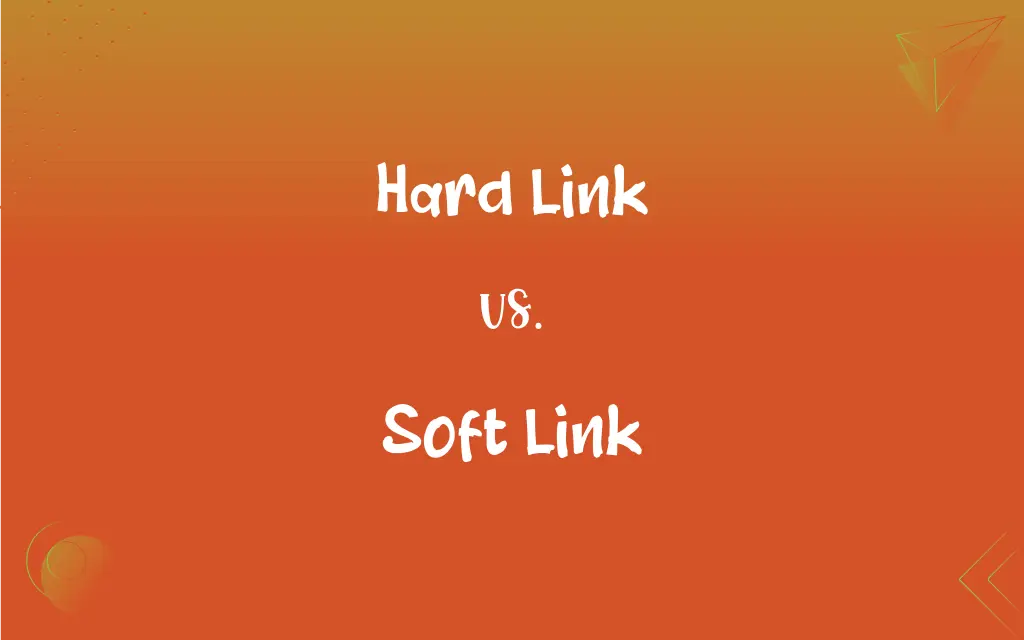Hard Link vs. Soft Link: What's the Difference?
Edited by Aimie Carlson || By Janet White || Published on February 28, 2024
A hard link is a direct mirror of a file, sharing the same inode, while a soft link (or symlink) is a separate file that points to the original file's location.

Key Differences
A hard link acts as a mirror copy of the original file, having the same inode number, thus directly linking to the file's data. In contrast, a soft link (or symbolic link) creates a separate file that points to the original file's path, acting as a shortcut.
When the original file is deleted, a hard link to the file remains accessible and contains the file's data. However, a soft link becomes a 'broken link' and cannot access the data once the original file is deleted.
Hard links do not consume additional disk space as they reference the same inode and data. Conversely, soft links require a small amount of disk space to store the path information of the original file.
Hard links are limited to the same filesystem as they share the same inode number. Soft links, however, can cross filesystem boundaries as they are merely pointers to a file path.
Hard links are indistinguishable from the original file as they appear as a regular file and share the inode. Soft links are identifiable as they show the path to the original file and have a different inode number.
ADVERTISEMENT
Comparison Chart
Definition
Direct mirror of a file, shares same inode
Separate file pointing to original file's path
Deletion Impact
Remains accessible, retains data
Becomes broken, loses access to data
Disk Space
Does not consume additional space
Requires space for path information
Filesystem Limitation
Restricted to same filesystem
Can cross filesystem boundaries
Identification
Indistinguishable from original, same inode
Shows path to original, different inode
ADVERTISEMENT
Hard Link and Soft Link Definitions
Hard Link
A hard link is a direct copy of a file sharing the same inode.
Creating a hard link to a video file allows access to the video from two locations.
Soft Link
A soft link is a separate file with its own inode.
The soft link and the original file have different inode numbers.
Hard Link
A hard link does not consume extra disk space.
Adding a hard link to a document doesn't use more disk space despite appearing as a separate file.
Soft Link
Soft links become broken if the original file is deleted.
Deleting the source image file renders the soft link to it unusable.
Hard Link
Hard links reference the same inode as the original file.
Both the hard link and its original file show the same inode number in the filesystem.
Soft Link
A soft link is a file that points to another file's path.
A soft link to a music file allows access to the song via a different path.
Hard Link
A hard link shares the actual data of the original file.
Deleting the original file does not affect the hard link as it still contains the data.
Soft Link
Soft links can point to files across different filesystems.
You can create a soft link to a file on an external drive.
Hard Link
Hard links are restricted to the same filesystem.
You cannot create a hard link to a file on a different partition.
Soft Link
A soft link uses a small amount of space to store the path.
Creating a soft link to a large video file only uses a bit of space for the path.
FAQs
Can soft links point to files on different filesystems?
Yes, soft links can reference files across different filesystems.
What happens to a hard link if the original file is deleted?
The hard link remains intact and accessible, retaining the file's data.
Do hard links use extra disk space?
No, hard links do not consume additional disk space; they share data with the original file.
How can I identify a soft link?
Soft links can be identified as they typically display the path to the original file.
Can I create a hard link to a directory?
Typically, hard links to directories are not allowed to prevent complex directory structures.
What is a hard link?
A hard link is a direct mirror of a file, sharing the same inode as the original file.
What is a soft link?
A soft link is a separate file that points to the path of the original file, acting like a shortcut.
What happens to a soft link if the original file is deleted?
The soft link becomes a broken link, losing access to the original file's data.
Can hard links be created across network drives?
No, hard links cannot be created for files on network drives or different filesystems.
Are hard links visible across user accounts?
Yes, hard links are visible to any user that has access to the original file's location.
Can hard links be used for backup purposes?
Hard links can be used for backups, but they are not independent copies; if the file's content is altered, it reflects in the hard link.
Do soft links work after moving the original file?
No, if the original file is moved or renamed, the soft link will not update automatically and may become broken.
Can soft links link to directories?
Yes, soft links can point to directories as well as files.
How are hard links identified?
Hard links are not easily identifiable as they appear as regular files and share the inode of the original file.
Are soft links visible across user accounts?
Soft links are visible across user accounts, but accessibility depends on the permissions of the target file.
Do hard links maintain file permissions?
Yes, since hard links share the same inode, they maintain the file permissions of the original file.
Do soft links maintain file permissions?
Soft links have their own permissions, but accessing the file through the link will depend on the original file's permissions.
How are soft links useful in file management?
Soft links are useful for creating shortcuts and organizing files without duplicating data.
How is file deletion handled differently by hard links and soft links?
In hard links, file deletion does not affect the link, while in soft links, deleting the original file breaks the link.
Is it possible to identify the original file from a hard link?
No, hard links are indistinguishable from the original file in terms of data and inode.
About Author
Written by
Janet WhiteJanet White has been an esteemed writer and blogger for Difference Wiki. Holding a Master's degree in Science and Medical Journalism from the prestigious Boston University, she has consistently demonstrated her expertise and passion for her field. When she's not immersed in her work, Janet relishes her time exercising, delving into a good book, and cherishing moments with friends and family.
Edited by
Aimie CarlsonAimie Carlson, holding a master's degree in English literature, is a fervent English language enthusiast. She lends her writing talents to Difference Wiki, a prominent website that specializes in comparisons, offering readers insightful analyses that both captivate and inform.
































































